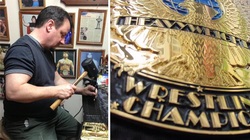
BY ZACH LINDER
Dave Millican has been crafting championships all of his life. Long before he became the man responsible for many of the WWE titles you see today, the “Ace of Belts” was dreaming up his own designs in the front of the family television.
“When I became a fan as a kid in the ’70s, we didn’t have everything kids have today like video games and replica titles,” Millican told WWEClassics.com. “So I had to make my own.”
Starting out with makeshift titles built out of cardboard and aluminum, the young Tennessee native later graduated to heavier metal and better materials. When Millican wanted the real deal, he looked up Reggie Parks, the man who was making the championships used on television. Parks was a Canadian grappler who had a brief stint as a WWE referee before settling in Tuscon, Ariz., to establish his title manufacturing business in the 1980s. Over the following decades, Parks created the titles well-known to many wrestling fans and influenced Millican, who was eager to learn.
“He once said to me, ‘I’m not going to be around forever. There needs to be somebody that’s honest and going to put out quality work,’ ” Millican said. “He held my hand through the process. I’m where I’m at thanks to Reggie.”
Today, Parks and Millican have a business partnership, but Reggie’s last titles for WWE were created during WWE’s New Generation heyday of 1996. More than a decade later, Millican became WWE’s go-to craftsman after asserting himself in the business by creating titles for organizations like Ring of Honor and New Japan Pro Wrestling.
“I’ve made championships for companies all over the world, and when WWE came to me a few years ago, that’s when it all came full circle,” Millican said.
Since 2008, the “Ace of Belts” has been responsible for the redesigned copper WWE Tag Team Championships, the World Heavyweight Championship, the relaunched “classic” Intercontinental Title and the dynamic NXT Championship. In addition, his workshop collaborated with Orange County Choppers to create the brand spanking new WWE Championship.
Millican is a walking encyclopedia of wrestling title knowledge, and his expertise as a craftsman makes him the current foremost authority on championships. WWEClassics.com recently asked him to select the 10 most beautiful championship belts in the history of wrestling — in no particular order, of course.
As Millican said, “It’s like asking me to choose my favorite child.”
Dave Millican has been crafting championships all of his life. Long before he became the man responsible for many of the WWE titles you see today, the “Ace of Belts” was dreaming up his own designs in the front of the family television.
“When I became a fan as a kid in the ’70s, we didn’t have everything kids have today like video games and replica titles,” Millican told WWEClassics.com. “So I had to make my own.”
Starting out with makeshift titles built out of cardboard and aluminum, the young Tennessee native later graduated to heavier metal and better materials. When Millican wanted the real deal, he looked up Reggie Parks, the man who was making the championships used on television. Parks was a Canadian grappler who had a brief stint as a WWE referee before settling in Tuscon, Ariz., to establish his title manufacturing business in the 1980s. Over the following decades, Parks created the titles well-known to many wrestling fans and influenced Millican, who was eager to learn.
“He once said to me, ‘I’m not going to be around forever. There needs to be somebody that’s honest and going to put out quality work,’ ” Millican said. “He held my hand through the process. I’m where I’m at thanks to Reggie.”
Today, Parks and Millican have a business partnership, but Reggie’s last titles for WWE were created during WWE’s New Generation heyday of 1996. More than a decade later, Millican became WWE’s go-to craftsman after asserting himself in the business by creating titles for organizations like Ring of Honor and New Japan Pro Wrestling.
“I’ve made championships for companies all over the world, and when WWE came to me a few years ago, that’s when it all came full circle,” Millican said.
Since 2008, the “Ace of Belts” has been responsible for the redesigned copper WWE Tag Team Championships, the World Heavyweight Championship, the relaunched “classic” Intercontinental Title and the dynamic NXT Championship. In addition, his workshop collaborated with Orange County Choppers to create the brand spanking new WWE Championship.
Millican is a walking encyclopedia of wrestling title knowledge, and his expertise as a craftsman makes him the current foremost authority on championships. WWEClassics.com recently asked him to select the 10 most beautiful championship belts in the history of wrestling — in no particular order, of course.
As Millican said, “It’s like asking me to choose my favorite child.”
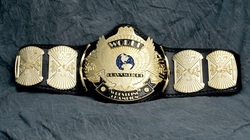
“Winged Eagle” WWE Championship
“It’s hard to beat that classic ‘Winged Eagle,’ ” Millican declared. “It’s endured since it debuted in 1988.”
Created by Reggie Parks and held by every WWE Champion from “Macho Man” Randy Savage to “Stone Cold” Steve Austin, the design remains a favorite with WWE fans.
“When there was buzz that there was going to be a new title, I was getting emails from fans saying, ‘Please tell me it’s at least a revamped ‘Winged Eagle,’ ” Millican said. “I personally love the belt. It’s an iconic design and people are still asking about it today.”
Although the title has become iconic, WWE’s original design requests were as simple as could be.
“The belt came about because [former WWE producer] Chief Jay Strongbow called Reggie and said, ‘We want a new title where the eagle consumes the main plate,’ ” Millican explained. “Reggie and the engraving company took it from there.”
“It’s hard to beat that classic ‘Winged Eagle,’ ” Millican declared. “It’s endured since it debuted in 1988.”
Created by Reggie Parks and held by every WWE Champion from “Macho Man” Randy Savage to “Stone Cold” Steve Austin, the design remains a favorite with WWE fans.
“When there was buzz that there was going to be a new title, I was getting emails from fans saying, ‘Please tell me it’s at least a revamped ‘Winged Eagle,’ ” Millican said. “I personally love the belt. It’s an iconic design and people are still asking about it today.”
Although the title has become iconic, WWE’s original design requests were as simple as could be.
“The belt came about because [former WWE producer] Chief Jay Strongbow called Reggie and said, ‘We want a new title where the eagle consumes the main plate,’ ” Millican explained. “Reggie and the engraving company took it from there.”
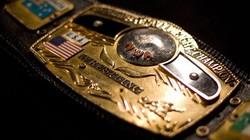
NWA World Heavyweight Championship
At one time considered to be the symbol of excellence in professional wrestling, the NWA World Heavyweight Title was held by legendary WWE Hall of Famers like Dusty Rhodes, Terry Funk and, of course, Ric Flair.
“It was originally made by a jeweler in Mexico in 1973 with a red velvet strap,” Millican said. “But the strap didn’t hold up, and they changed it over to the black lace leather while Jack Brisco was champion.”
While the same design remains with the National Wrestling Alliance and is still defended to this day, the original belt is now located in WWE’s Stamford, Conn., headquarters. According to WWE archivist Ben Brown, it’s definitely the genuine article because of a dent in the dome, courtesy of Harley Race’s skull.
At one time considered to be the symbol of excellence in professional wrestling, the NWA World Heavyweight Title was held by legendary WWE Hall of Famers like Dusty Rhodes, Terry Funk and, of course, Ric Flair.
“It was originally made by a jeweler in Mexico in 1973 with a red velvet strap,” Millican said. “But the strap didn’t hold up, and they changed it over to the black lace leather while Jack Brisco was champion.”
While the same design remains with the National Wrestling Alliance and is still defended to this day, the original belt is now located in WWE’s Stamford, Conn., headquarters. According to WWE archivist Ben Brown, it’s definitely the genuine article because of a dent in the dome, courtesy of Harley Race’s skull.
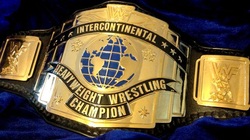
“Classic” Intercontinental Championship
The first title the “Ace of Belts” was commissioned to create for WWE was the Intercontinental Championship introduced in 2008. At that time, the title had a sleeker oval look, but it was disposed of by Cody Rhodes at WWE Hell in a Cell 2011. With his eye on wrestling history, Cody reinstated the same design held by legendary grapplers like Ricky Steamboat, Rick Rude and Mr. Perfect. It has remained with a white strap since.
“For a fairly simple design, it’s enduring,” Millican said of the title currently held by Wade Barrett. “I think the white looks great, but it’s just not practical It gets all kind of scuff marks on it.”
While the white leather makes the title unique, it truly stood out in the late ’80s when Ultimate Warrior changed the color scheme.
“The yellow one that Warrior had is still very popular among collectors,” Millican said. “It makes it look like a whole different belt.”
The first title the “Ace of Belts” was commissioned to create for WWE was the Intercontinental Championship introduced in 2008. At that time, the title had a sleeker oval look, but it was disposed of by Cody Rhodes at WWE Hell in a Cell 2011. With his eye on wrestling history, Cody reinstated the same design held by legendary grapplers like Ricky Steamboat, Rick Rude and Mr. Perfect. It has remained with a white strap since.
“For a fairly simple design, it’s enduring,” Millican said of the title currently held by Wade Barrett. “I think the white looks great, but it’s just not practical It gets all kind of scuff marks on it.”
While the white leather makes the title unique, it truly stood out in the late ’80s when Ultimate Warrior changed the color scheme.
“The yellow one that Warrior had is still very popular among collectors,” Millican said. “It makes it look like a whole different belt.”
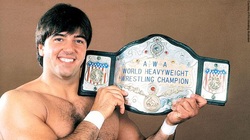
“Inmate Belt” AWA World Heavyweight Championship
Nicknamed the “Inmate Belt” by collectors because it was created in a state prison in Wisconsin, the AWA World Heavyweight Championship was one of the most desired titles in wrestling throughout the 1970s.
“Nick [Bockwinkel] always called it his ‘diamond studded license plate,’ ” Millican told WWEClassics.com. “You’d never know it [was made in a prison] from looking at it. The craftsmanship is remarkable.”
The title was so elite, it was only held by six competitors: Bockwinkel, Verne Gagne, Otto Wanz, Jumbo Tsuruta, Rick Martel and, finally, Stan Hansen, who ran off with it to Japan. When the AWA demanded it be returned, “The Lariat” ran it over with his truck and mailed it back complete with mud tracks.
Nicknamed the “Inmate Belt” by collectors because it was created in a state prison in Wisconsin, the AWA World Heavyweight Championship was one of the most desired titles in wrestling throughout the 1970s.
“Nick [Bockwinkel] always called it his ‘diamond studded license plate,’ ” Millican told WWEClassics.com. “You’d never know it [was made in a prison] from looking at it. The craftsmanship is remarkable.”
The title was so elite, it was only held by six competitors: Bockwinkel, Verne Gagne, Otto Wanz, Jumbo Tsuruta, Rick Martel and, finally, Stan Hansen, who ran off with it to Japan. When the AWA demanded it be returned, “The Lariat” ran it over with his truck and mailed it back complete with mud tracks.
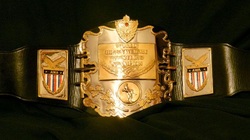
1986 AWA World Heavyweight Championship
After Stan Hansen destroyed the original version of the AWA Championship, Verne Gagne’s organization was forced to replace it. But instead of switching their iconic title with a clone, the AWA opted for a complete redesign.
This championship was held by even fewer competitors than the previous version, a total of five before the organization shuttered for good: Nick Bockwinkel (who was awarded the title after Hansen’s departure), Curt Hennig, Larry Zbyszko, Mr. Saito and the man most closely associated with the design, Jerry Lawler.
“Being in Memphis, it’s against the law to not be a Jerry Lawler fan,” Millican said with a laugh. “I told him I always wanted him to win the big ‘Inmate Belt’ from Nick. And Jerry said, ‘Oh, I hated that belt. It was so gaudy looking. A belt should be like a piece of jewelry. And that’s what I got, the piece of jewelry.’ ”
After Stan Hansen destroyed the original version of the AWA Championship, Verne Gagne’s organization was forced to replace it. But instead of switching their iconic title with a clone, the AWA opted for a complete redesign.
This championship was held by even fewer competitors than the previous version, a total of five before the organization shuttered for good: Nick Bockwinkel (who was awarded the title after Hansen’s departure), Curt Hennig, Larry Zbyszko, Mr. Saito and the man most closely associated with the design, Jerry Lawler.
“Being in Memphis, it’s against the law to not be a Jerry Lawler fan,” Millican said with a laugh. “I told him I always wanted him to win the big ‘Inmate Belt’ from Nick. And Jerry said, ‘Oh, I hated that belt. It was so gaudy looking. A belt should be like a piece of jewelry. And that’s what I got, the piece of jewelry.’ ”
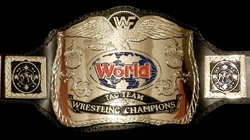
“Classic” WWE World Tag Team Championship
Active for several decades, these World Tag Team Championships are immediately recognizable to long time WWE fans who remember seeing them in the hands of The Hart Foundation, Demolition and The New Age Outlaws.
“The main plate was a lot bigger than a lot of other tag titles, and it really stood out because of that,” Millican said. “It evolved in a great way. The original versions Reggie made were silver, then he went to silver and gold and then, finally, they were all gold by the late ’80s or early ’90s.”
The titles boast one of the longest tenures of any championship in WWE, having debuted in the mid-’80s and sticking around until the early 2000s.
“Collectors still seek them out,” Millican explained. “You know a design is a classic, not only because it’s been around for a long time, but because it still gets so much attention.”
Active for several decades, these World Tag Team Championships are immediately recognizable to long time WWE fans who remember seeing them in the hands of The Hart Foundation, Demolition and The New Age Outlaws.
“The main plate was a lot bigger than a lot of other tag titles, and it really stood out because of that,” Millican said. “It evolved in a great way. The original versions Reggie made were silver, then he went to silver and gold and then, finally, they were all gold by the late ’80s or early ’90s.”
The titles boast one of the longest tenures of any championship in WWE, having debuted in the mid-’80s and sticking around until the early 2000s.
“Collectors still seek them out,” Millican explained. “You know a design is a classic, not only because it’s been around for a long time, but because it still gets so much attention.”
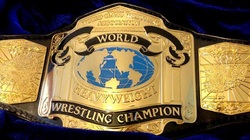
WCWA World Heavyweight Championship
The signature championship of the Dallas-based World Class Championship Wrestling organization (the WCWA initials stood for the governing body – the World Class Wrestling Association), this title made its debut in 1986 when Chris Adams was champion and was used until World Class shuttered in 1990.
“It was a big, impressive title with a lot of hidden details in the side plates,” admired Millican. “For instance, the side plates have continent maps on them. At a glance, it looks like they’re just a bunch of gold nuggets, but there are tons of details in these maps.”
The man most closely associated with this title is Kerry Von Erich, who was the World Class Champion nine times and held this version on four occasions. In 1988, AWA Champion Jerry Lawler defeated The Texas Tornado to unify the titles. Following a series of controversies, “King” became the final man to hold the championship.
“For its time, it was a very big belt and made a striking appearance,” Millican said. “It was a great representation of what a champion should wear.”
The signature championship of the Dallas-based World Class Championship Wrestling organization (the WCWA initials stood for the governing body – the World Class Wrestling Association), this title made its debut in 1986 when Chris Adams was champion and was used until World Class shuttered in 1990.
“It was a big, impressive title with a lot of hidden details in the side plates,” admired Millican. “For instance, the side plates have continent maps on them. At a glance, it looks like they’re just a bunch of gold nuggets, but there are tons of details in these maps.”
The man most closely associated with this title is Kerry Von Erich, who was the World Class Champion nine times and held this version on four occasions. In 1988, AWA Champion Jerry Lawler defeated The Texas Tornado to unify the titles. Following a series of controversies, “King” became the final man to hold the championship.
“For its time, it was a very big belt and made a striking appearance,” Millican said. “It was a great representation of what a champion should wear.”
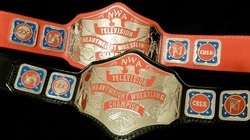
NWA World Television Championship
One of the most unique titles ever defended in a major organization, the NWA Television Title had a striking red appearance and featured network logos on the side plates. Held by a “who’s who” of WWE Hall of Famers and ring icons, including Dusty Rhodes, Arn Anderson, Tully Blanchard, Sting, The Great Muta and Steve Austin, the title remains a sought-after design by collectors.
“The leather started red, then it went to black with a red backing that really stood out,” Millican explained.
The design was abandoned by WCW in the early ’90s when the Turner-owned organization split from the National Wrestling Alliance. The championship remained, but was represented by a new, more generic design.
Eventually, the title lost its luster and Scott Hall threw it in the trash. Perhaps the once-revered Television Championship wouldn’t have had the same fate if it had kept the quirky red design.
One of the most unique titles ever defended in a major organization, the NWA Television Title had a striking red appearance and featured network logos on the side plates. Held by a “who’s who” of WWE Hall of Famers and ring icons, including Dusty Rhodes, Arn Anderson, Tully Blanchard, Sting, The Great Muta and Steve Austin, the title remains a sought-after design by collectors.
“The leather started red, then it went to black with a red backing that really stood out,” Millican explained.
The design was abandoned by WCW in the early ’90s when the Turner-owned organization split from the National Wrestling Alliance. The championship remained, but was represented by a new, more generic design.
Eventually, the title lost its luster and Scott Hall threw it in the trash. Perhaps the once-revered Television Championship wouldn’t have had the same fate if it had kept the quirky red design.
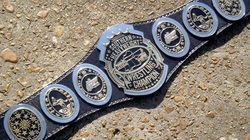
AWA Southern Heavyweight Championship
“It’s the belt that made me a fan of belts in the first place,” Millican said of the AWA Southern Heavyweight Championship. “I had been a fan for years and had never paid that much attention to belts until I saw that one. There was just something about the design.”
Known by many names, the Memphis-based title boasts a lineage that dates back to 1939. This design, though, was most closely associated with Jerry Lawler and his various rivals in Tennessee throughout the 1980s.
“Aesthetically, it’s a very simple belt, especially compared to today’s belts,” the “Ace of Belts” admitted. “I think all those flashes of chrome when the TV lights would hit it just did the trick for me. I was hooked into belts from that point on.”
Although the exact design has been retired, the title’s lineage lives on in The River City’s Memphis Wrestling organization.
“It’s the belt that made me a fan of belts in the first place,” Millican said of the AWA Southern Heavyweight Championship. “I had been a fan for years and had never paid that much attention to belts until I saw that one. There was just something about the design.”
Known by many names, the Memphis-based title boasts a lineage that dates back to 1939. This design, though, was most closely associated with Jerry Lawler and his various rivals in Tennessee throughout the 1980s.
“Aesthetically, it’s a very simple belt, especially compared to today’s belts,” the “Ace of Belts” admitted. “I think all those flashes of chrome when the TV lights would hit it just did the trick for me. I was hooked into belts from that point on.”
Although the exact design has been retired, the title’s lineage lives on in The River City’s Memphis Wrestling organization.
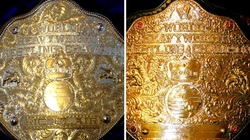
The “Big Gold Belt”
Perhaps the most iconic belt design in wrestling history, the “Big Gold Belt” maintains a legacy that is represented today by the World Heavyweight Championship. But for such a recognizable title, the design has some seriously obscure beginnings.
“Nelson Royal was a wrestler who had ties with both the Jim Crockett Promotions office and the NWA,” Millican explained. “In addition to being a well-known wrestler in his own right, he was heavily involved in rodeos.”
When Jim Crockett was looking to redesign the NWA World Heavyweight Championship in the mid-’80s, Royal led Crockett to Crumline Silversmiths in Reno, Nev., a business that dates back to 1948 and specializes in western-style rodeo belt buckles to this day.
“That [original] belt was made from real silver,” Millican revealed. “It was not all gold-plated like we do them today.”
As far as its well-known nickname, the exact origins are unclear.
“Somebody credited Gordon Solie with it,” Millican said, but he prefered to consider another theory. “Ric Flair once opened up his robe standing in the ring and said, ‘There it is. There’s the big gold.’ And the name stuck.”
Since its debut around the waist of The Nature Boy on Valentine’s Day in 1986, the design has undergone several small changes, but remains a revered championship. It has represented the NWA Championship, WCW Championship, WCW’s International Championship and today’s World Heavyweight Championship, which Millican has the privilege of making.
Perhaps the most iconic belt design in wrestling history, the “Big Gold Belt” maintains a legacy that is represented today by the World Heavyweight Championship. But for such a recognizable title, the design has some seriously obscure beginnings.
“Nelson Royal was a wrestler who had ties with both the Jim Crockett Promotions office and the NWA,” Millican explained. “In addition to being a well-known wrestler in his own right, he was heavily involved in rodeos.”
When Jim Crockett was looking to redesign the NWA World Heavyweight Championship in the mid-’80s, Royal led Crockett to Crumline Silversmiths in Reno, Nev., a business that dates back to 1948 and specializes in western-style rodeo belt buckles to this day.
“That [original] belt was made from real silver,” Millican revealed. “It was not all gold-plated like we do them today.”
As far as its well-known nickname, the exact origins are unclear.
“Somebody credited Gordon Solie with it,” Millican said, but he prefered to consider another theory. “Ric Flair once opened up his robe standing in the ring and said, ‘There it is. There’s the big gold.’ And the name stuck.”
Since its debut around the waist of The Nature Boy on Valentine’s Day in 1986, the design has undergone several small changes, but remains a revered championship. It has represented the NWA Championship, WCW Championship, WCW’s International Championship and today’s World Heavyweight Championship, which Millican has the privilege of making.
 RSS Feed
RSS Feed